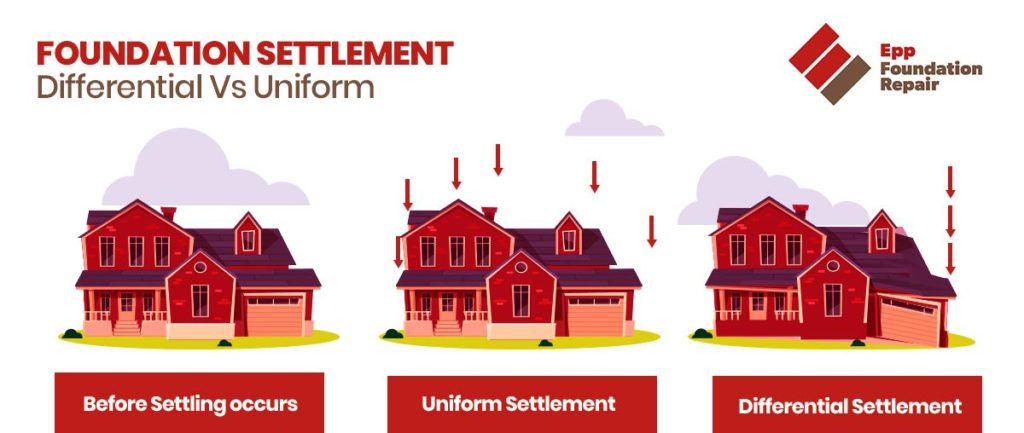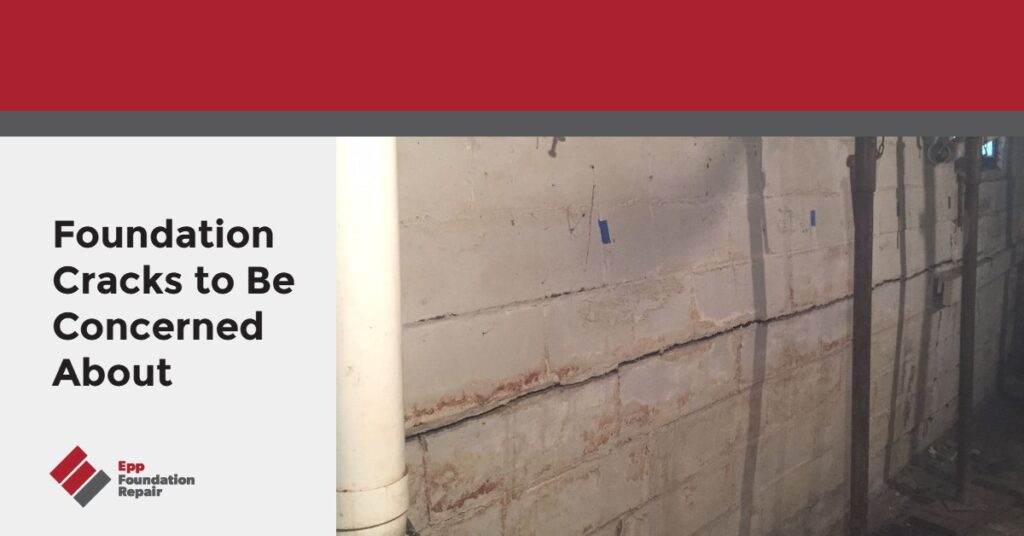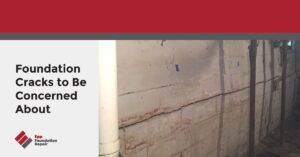Wondering which foundation cracks to be concerned about? If so, don’t hit that back button because that’s what we’re going to talk about in this article. We’re going to go over the difference between structural and non-structural foundation cracks, the leading causes of structural foundation cracks, how foundation cracks are repaired, and more.
You Should Be Concerned About Structural Foundation Cracks
There are two types of foundation cracks: structural and non-structural. You should be concerned about structural foundation cracks.
Structural vs. non-structural foundation cracks
Structural foundation cracks are foundation cracks to be concerned about because they affect your home’s structural integrity. Non-structural foundation cracks are just ugly.
Causes of structural foundation cracks
Structural foundation cracks are mainly caused by differential settlement (caused by various things) and hydrostatic pressure.
Differential settlement happens when the soil under the foundation moves. This movement might be due to erosion, clay soil that swells when it soaks up moisture, or something else. This movement in the soil can cause a foundation to settle into the ground unevenly. See the below graphic.
Hydrostatic pressure can also cause structural foundation cracks. This happens when there’s excess moisture in the soil around the foundation. If the pressure isn’t relieved via good drainage, hydrostatic pressure will build up and push against the foundation walls. This can result in cracked and bowed basement walls. See the two photos below for an example of what this looks like.

How To Spot Structural Foundation Cracks
The following are signs you should be concerned about a foundation crack because it’s probably structural:
- Horizontal cracks with or without bowing
- Stair step cracks in brick or masonry
- Diagonal cracks from the corners of doors and windows
- Diagonal cracks in the middle of a wall
- Cracks that are wider at one end
- Cracks that are wider than 1/10 inch
- Cracks that are getting either longer, wider, or both
- A series of vertical cracks next to each other
- Cracks that go across a ceiling and down a wall
If you see any of the above cracks or something not mentioned here that looks suspicious, contact a foundation repair contractor or structural engineer immediately. Foundation problems don’t go away. They get worse if they’re not fixed. If you wait, you’ll pay more to repair the problem.
A few words about non-structural cracks…
Most non-structural cracks are caused by shrinkage during the concrete curing process (often vertical hairline cracks) and paint build-up over the years. For more information, see, Structural or Non-Structural? Understanding Foundation Cracks.
Causes Of Structural Foundation Cracks
The causes of structural foundation cracks are various and include (but aren’t limited to):
- Soil that wasn’t correctly compacted before construction – Backfilled soil needs to be tamped down before anything gets built on it. If the soil is improperly prepared, the building will sink into the ground unevenly after it’s built.
- Expansive soil – Expansive soil expands when it gets wet and shrinks when it dries out. This usually happens on a seasonal basis and can lead to differential settlement and foundation cracks.
- Weather changes – Suppose you build a house on expansive soil during the dry season. When the weather changes and it starts raining, the soil will expand, creating movement under the house. This can cause differential settlement leading to cracks in the foundation.
- Poor drainage around the foundation – Poor drainage will lead to the build-up of hydrostatic pressure, which will push against foundation walls and cause them to crack and bow inward.
- Tree roots – Trees get thirsty and will “drink” water from the soil under your foundation. As the soil dries out, voids form. When the foundation settles into the voids, you’ll have differential settlement leading to foundation cracks.
- Natural disasters like earthquakes and floods – This one probably needs no explanation.
- Digging too close to the foundation – If your neighbor decides to do some heavy excavation too close to your house, it could destabilize the soil under the foundation and lead to differential settlement and foundation cracks.
- Poor construction – Hey, it happens!
All of the above can cause differential settlement and lead to structural foundation cracks to be concerned about. However, as we mentioned above, hydrostatic pressure can also cause structural foundation cracks in a foundation wall.
Foundation Cracks To Be Concerned About
You should be concerned about all structural foundation cracks because they affect your home’s structural integrity. Structural cracks should always be inspected by an experienced foundation repair contractor or a structural engineer.
In contrast, non-structural cracks don’t immediately affect a building’s structural integrity. However, that doesn’t mean you should ignore non-structural cracks. For example, vertical, non-structural cracks in a basement wall were probably caused by shrinkage during the concrete curing process. Suppose hydrostatic pressure has built up in the soil around the foundation because of poor drainage. In that case, it could push water through these non-structural cracks and into your basement.
Non-structural cracks should always be monitored to ensure they’re not getting bigger. If they are, they may be structural cracks.
Use common sense. If a foundation crack looks serious, it probably is. Error on the side of caution and ask a professional to look at it. Also, look for other signs of foundation trouble. We’ll talk more about this below.
How Are Foundation Cracks Repaired
Repair options for foundation cracks depend on what caused the crack. Was it foundation settlement or hydrostatic pressure pushing against a foundation wall?
If the foundation crack was caused by hydrostatic pressure, the following are possible repair options to stabilize the foundation wall and prevent any further bowing:
- Carbon fiber straps
- Wall plate anchors
- Helical wall anchors (tiebacks)
If the foundation crack was caused by differential settlement underpinning, using push piers or helical piers will probably be the solution.
Common Signs Of Foundation Problems
Foundation cracks are just one sign of a foundation problem. Other signs include:
- Stair step cracks in brick or masonry
- Doors and windows that aren’t opening and closing properly
- Doors opening and closing by themselves
- Large cracks from the corners of doors and windows
- Floor cracks
- Wall cracks
- Uneven floors
- Ceiling cracks
- Cracks that go across the ceiling and down a wall
- Moldings that are separating from the wall or ceiling
- Wrinkled or torn wallpaper (The wall behind the wallpaper might be cracked.)
- Bowed walls
- Chimneys and porches that are separating from the house
- Ceilings and floors that are no longer in contact with the wall
If you see any of the above – or anything else suspicious – contact a professional for an inspection. Foundation problems get worse over time, so don’t delay. The faster you act, the more money you’ll save on repair costs.
If you’re concerned about foundation cracks in your home and are in our service area in Nebraska, Iowa, Kansas, and Missouri, contact us today for an inspection and estimate.







